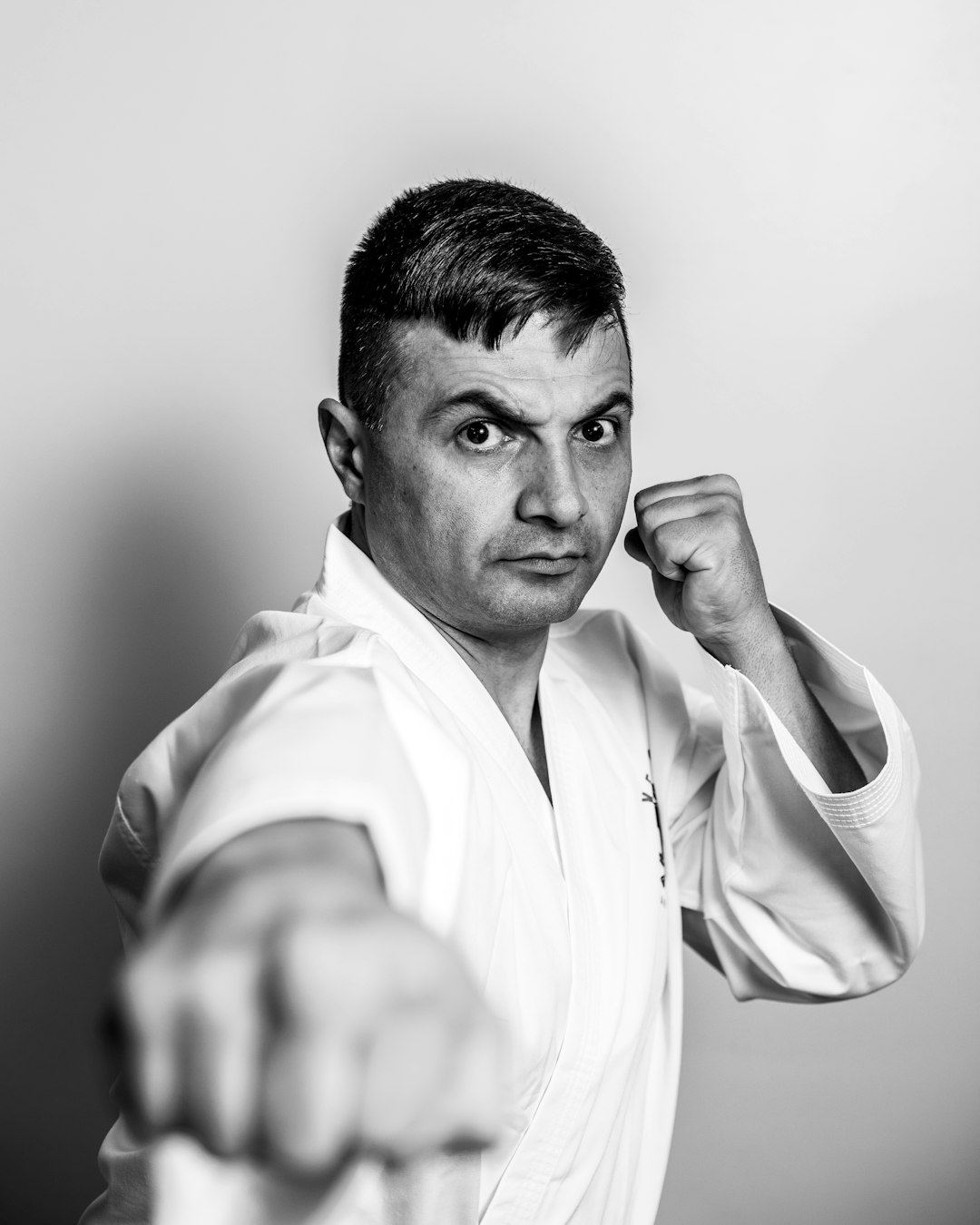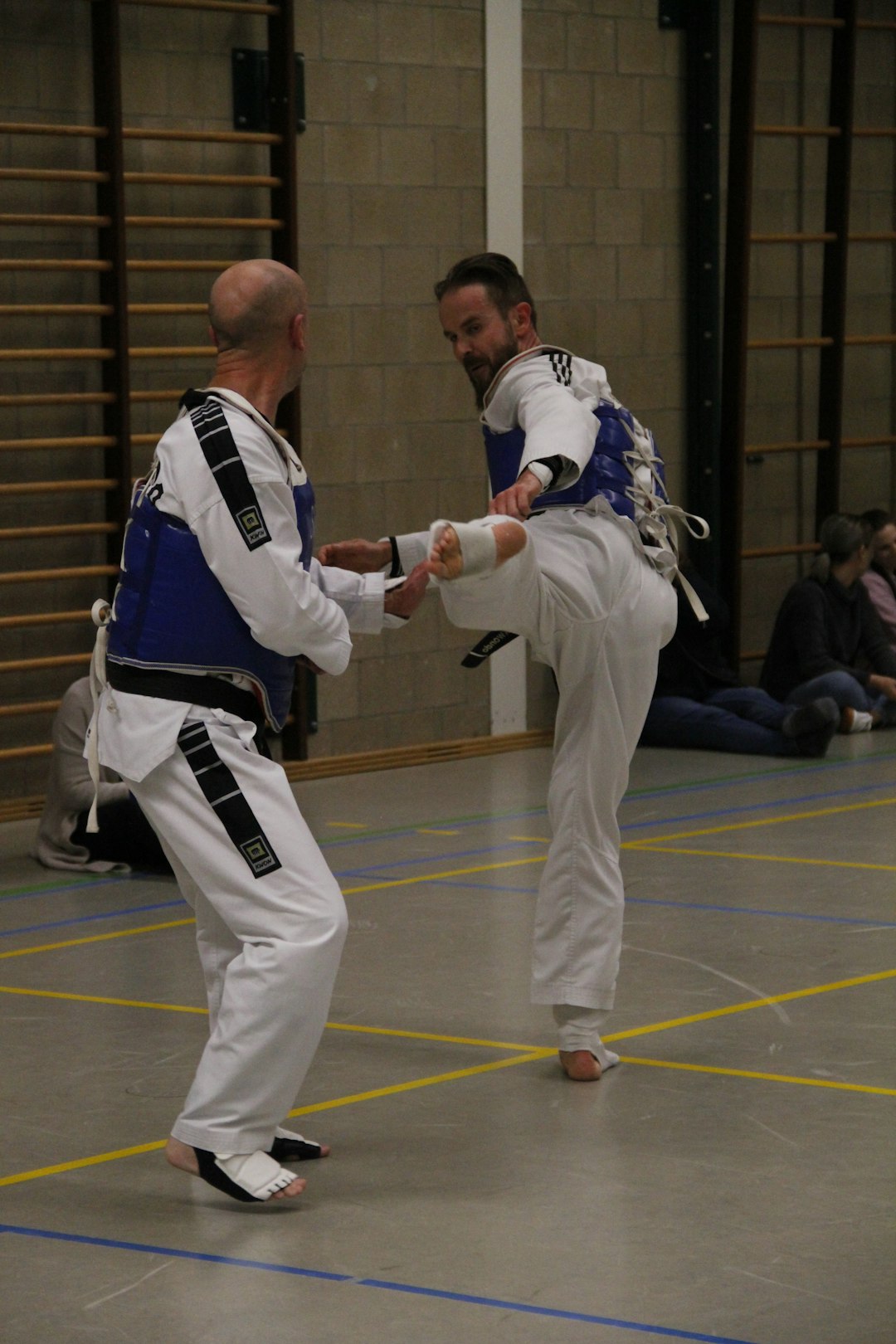The karate suit, known as a gi, is an essential component of traditional karate, serving both practical and ceremonial functions. It consists of a jacket, trousers, and a belt that indicate the wearer's rank, traditionally made from sturdy cotton or hemp fabric to ensure durability and comfort during training. The jacket, called the uwagi, extends beyond the waist for optimal movement, while the nagi trousers are straight-legged with adjustable ankle ties. While maintaining its traditional design, the gi has slightly evolved over time to accommodate modern training needs while retaining its cultural significance and rich history within karate. The suit is tailored to facilitate the execution of karate techniques, with protective features like reinforced knees and elbows for safety during physical engagements. The precise tailoring balances mobility with fit, and the traditional dressing protocols emphasize discipline and respect for the martial art's etiquette, which is central to the philosophy of karate. The karate suit called, a garment that transcends mere attire, symbolizes the practitioner's commitment to the sport and its heritage.
Karate enthusiasts and practitioners alike are familiar with the distinctive attire that adorns martial artists as they perform their disciplined movements and forms. Often referred to colloquially as a “karate suit,” this garment is officially known as a gi. This article delves into the significance of the traditional karate outfit, exploring its composition, key features, and how it has evolved while maintaining its deep-rooted traditions. Join us as we understand the profound respect the gi commands, not only as part of the martial art but also as a symbol of discipline, respect, and cultural heritage.
- Understanding the Traditional Karate Suit: The Gi's Significance and Composition
- Key Features of a Standard Karate Gi: Fabric, Fit, and Functionality
- Evolving with Tradition: Modern Variations of Karate Training Attire
- Cultivating Respect: The Protocols and Etiquette Surrounding the Donning of a Karate Gi
Understanding the Traditional Karate Suit: The Gi's Significance and Composition

When engaging in karate, the practitioner dons a traditional garment known as a gi. This garment is not merely a uniform but a symbol of respect and discipline within the martial arts community. The gi typically consists of a jacket and trousers made from heavy cotton or hemp fabric, with a belt, or obi, that signifies the wearer’s rank. The top, which buttons up the front, is known as the uwagi, and it reaches just past the waist, allowing for a full range of motion during practice and performance. The trousers, called nagi, are straight-legged and secured by ties or strings at the ankles. The gi’s composition and design have remained relatively unchanged over the decades, reflecting the rich history and tradition of karate. Is the traditional karate suit called a gi? Yes, the karate suit is specifically named a gi, and it serves as both a functional garment for training and a ceremonial attire that honors the discipline’s heritage. The gi’s fabric and cut are chosen to facilitate movement and allow practitioners to execute techniques with clarity and precision, while also adhering to the customs that define karate practice.
Key Features of a Standard Karate Gi: Fabric, Fit, and Functionality

When practicing the martial art of karate, the practitioner’s attire plays a crucial role in ensuring both performance and respect for tradition. The karate suit, known as a gi, is a key component of the training regimen. A standard karate gi typically consists of a jacket, trousers, a belt (obi), and sometimes a vest or skirt (uwagi) for women. The fabric of a karate gi is usually made of cotton or hemp blend, which provides durability and comfort during rigorous training sessions. This choice of material allows for a high level of functionality; it absorbs sweat effectively and withstands the friction from repetitive movements on mats or floors.
The fit of a karate gi is designed to be somewhat loose yet not excessively baggy, allowing for ease of movement while maintaining a form-fitting silhouette. This enables practitioners to perform kata and kumite with optimal flexibility. The functionality of the gi extends beyond its fabric; it also includes thoughtful design elements such as reinforced knees and elbows, which protect the wearer during falls or sparring sessions. Additionally, the lapels on the jacket are often secured with buttons to prevent them from flapping during motion, and pockets are usually absent to avoid any distractions or hindrances during practice. The trousers are typically straight-legged and can be tied at the ankles for a secure fit, ensuring that they do not ride up or hinder footwork. In summary, the karate suit called a gi is an essential element of karate practice, designed with features that respect tradition while supporting the physical demands of the martial art.
Evolving with Tradition: Modern Variations of Karate Training Attire

Karate, a discipline rooted in the Ryukyu Islands of Japan and now an Olympic sport, has seen its practices and paraphernalia evolve over time while maintaining the integrity of its traditional values. The quintessential attire for any karateka, or practitioner, is the karate suit, often referred to as a gi. This garment serves both functional and symbolic purposes, providing the range of motion necessary for the fluid execution of techniques while also representing the humility and respect inherent to martial arts. As the sport has become more widespread, variations of the traditional white cotton gi have emerged, catering to different needs and preferences within the modern karate training landscape. These include gis made from heavier materials for added durability during rigorous training sessions or those designed with a slightly tapered fit to offer a more streamlined silhouette, which some practitioners believe allows for better movement and execution of karate movements. The evolution of the karate suit has not only been influenced by practical considerations but also by the cultural integration of karate into diverse societies around the world. What is the traditional karate suit called? The traditional karate suit is commonly known as a ‘karate gi’. How have modern variations adapted for contemporary use while maintaining tradition? Modern variations of the karate gi, such as those made from different materials or with a tailored fit, have been designed to cater to both practical training needs and personal preferences, ensuring that the garment remains relevant and functional in today’s martial arts landscape.
Cultivating Respect: The Protocols and Etiquette Surrounding the Donning of a Karate Gi

When stepping into the realm of karate, one immediately encounters the significance of tradition and respect, a cornerstone of which is the proper donning of a karate suit, known as a gi. The gi is more than mere clothing; it represents the discipline and dedication inherent to martial arts practice. It is a garment steeped in history and symbolism, designed to facilitate both movement and respect for the art and fellow practitioners. When preparing to wear a gi, practitioners must first understand the protocols that accompany this traditional attire. Are the lapels fastened correctly? Is the belt tied with precision and care? These are questions of utmost importance as they reflect one’s readiness to engage in the practice of karate. The gi should have its collar folded neatly and secured with a series of small, even knots, the obi belt tied around the waist in a firm bow known as tsuudeshi. This ensures that the practitioner is not only physically prepared but also demonstrates an understanding of the etiquette that underpins the martial art’s philosophy and respect for the dojo and sensei. The ritual of putting on the gi, from the precise folding of the cloth to the careful tying of the belt, cultivates a mindset of discipline and respect, essential components of karate’s ethos. Is the practitioner aware of the importance of each movement when dressing in their gi? The answer is clear: every action must be deliberate and performed with an acute sense of awareness and reverence for the tradition they are upholding.
In conclusion, the karate outfit, known as a gi, serves as more than mere attire; it embodies the rich history and disciplined ethos of karate practice. Comprised of simple yet durable fabric and designed for functionality and fit, the gi is a testament to the sport’s traditional roots while accommodating modern training needs. Whether in a formal dojo or a personal practice space, the act of donning a gi cultivates respect for oneself, one’s peers, and the art of karate. Understanding the significance of this traditional suit is key for both practitioners and enthusiasts alike, as it remains an integral component of the martial art’s identity and culture.
